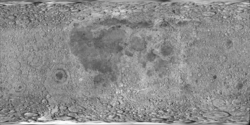Horatio (cráter)
cráter lunar
Horatio es un pequeño cráter lunar situado en el valle Taurus-Littrow. Los astronautas Eugene Cernan y Harrison Schmitt recorrieron su contorno a bordo de su rover durante la misión Apolo 17 en 1972, pero no se detuvieron en él.
| Horatio Cráter lunar | ||
|---|---|---|
 Localización de Horacio en el valle Taurus-Littrow. El Macizo sur se halla abajo a la izquierda, el Macizo Norte arriba en el centro, y Sculptured Hills arriba a la derecha. La barra de escala representa 5 km. | ||
| Coordenadas | 20°11′N 30°43′E / 20.19, 30.71 | |
| Diámetro | 380 m[1] | |
| Epónimo | Cráter nombrado por los astronautas (topónimo procedente del Lunar Topophotomap) | |
|
Localización sobre el mapa lunar | ||


Localización de Horatio, en el centro de la imagen (Lunar Topophotomap 43D1S1)
El cráter Camelot (más grande) se halla al noreste. La Estación Geológica 5 se encuentra en el borde sur de Camelot. Victory aparece al noroeste, y Brontë al suroeste.
Denominación
editarEl cráter fue nombrado por los astronautas en referencia a Horatio Hornblower, un personaje ficticio de los trabajos de Cecil Scott Forester.[3] La denominación tiene su origen en los topónimos utilizados en la hoja a escala 1/50.000 del Lunar Topophotomap con la referencia "43D1S1 Apollo 17 Landing Area".[4]
Véase también
editarReferencias
editar- ↑ Horatio, Gazetteer of Planetary Nomenclature, International Astronomical Union (Unión Astronómica Internacional) Working Group for Planetary System Nomenclature (WGPSN)
- ↑ Apollo 17 Image Library, Magazine 135/G
- ↑ Eric M. Jones, The Valley of Taurus-Littrow, Apollo 17 Lunar Surface Journal, Corrected Transcript and Commentary, 1995
- ↑ «43D1S1(50) Apollo 17 Landing Area». Lunar and Planetary Institute (en inglés).
- (WGPSN), IAU Working Group for Planetary System Nomenclature (13 de febrero de 2013). «Gazetteer of Planetary Nomenclature. 1:1 Million-Scale Maps of the Moon» (en inglés). UAI / USGS. Consultado el 6 de abril de 2016.
- Andersson, L. E.; Whitaker, E. A., (1982). NASA Catalogue of Lunar Nomenclature (en inglés). NASA RP-1097.
- Blue, Jennifer (25 de julio de 2007). «Gazetteer of Planetary Nomenclature» (en inglés). USGS. Consultado el 2 de enero de 2012.
- Bussey, B.; Spudis, P. (2004). The Clementine Atlas of the Moon (en inglés). Nueva York: Cambridge University Press. ISBN 0-521-81528-2.
- Cocks, Elijah E.; Cocks, Josiah C. (1995). Who's Who on the Moon: A Biographical Dictionary of Lunar Nomenclature (en inglés). Tudor Publishers. ISBN 0-936389-27-3.
- McDowell, Jonathan (15 de julio de 2007). «Lunar Nomenclature» (en inglés). Jonathan's Space Report. Consultado el 2 de enero de 2012.
- Menzel, D. H.; Minnaert, M.; Levin, B.; Dollfus, A.; Bell, B. (1971). «Report on Lunar Nomenclature by The Working Group of Commission 17 of the IAU». Space Science Reviews (en inglés) 12: 136.
- Moore, Patrick (2001). On the Moon (en inglés). Sterling Publishing Co. ISBN 0-304-35469-4.
- Price, Fred W. (1988). The Moon Observer's Handbook (en inglés). Cambridge University Press. ISBN 0521335000.
- Rükl, Antonín (1990). Atlas of the Moon (en inglés). Kalmbach Books. ISBN 0-913135-17-8.
- Webb, Rev. T. W. (1962). Celestial Objects for Common Telescopes, 6ª edición revisada (en inglés). Dover. ISBN 0-486-20917-2.
- Whitaker, Ewen A. (2003). Mapping and Naming the Moon (en inglés). Cambridge University Press. 978-0-521-54414-6.
- Wlasuk, Peter T. (2000). Observing the Moon (en inglés). Springer. ISBN 1-85233-193-3.
- «Lunar Impact Crater Database» (en inglés). Lunar and Planetary Institute (USRA). Consultado el 12 de septiembre de 2017.
Enlaces externos
editar- Referencia UAI del cráter
- LPI Digital Lunar Orbiter Photographic Atlas of the Moon
- Mapa LROC
- The-moon.wikispaces.com: Horatio (enlace roto disponible en Internet Archive; véase el historial, la primera versión y la última).
- Wikimedia Commons alberga una categoría multimedia sobre Horatio.

